1993 PONTIAC BONNEVILLE lights
[x] Cancel search: lightsPage 117 of 322
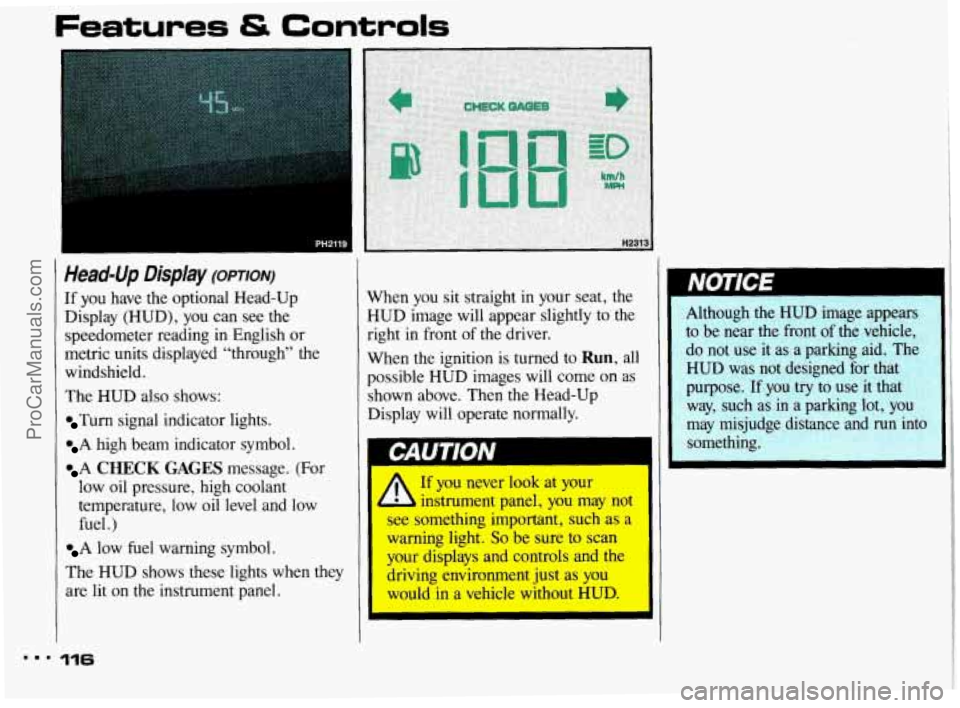
Features & Controls
pH2119
Head-Up Display (omorq
If you have the optional Head-Up
Display (HUD), you can see the
speedometer reading in English or
metric units displayed “through” the
windshield.
The HUD
also shows:
Turn signal indicator lights.
A high beam indicator symbol.
A CHECK GAGES message. (For
low oil pressure, high coolant
temperature, low oil level and low
fuel .)
A low fuel warning symbol.
The HUD shows these lights when they
are lit
on the instrument panel.
... 116
When you sit straight in your seat, the
HUD image will appear slightly to the
right in front
of the driver.
When the ignition is turned
to Run, all
possible HUD images will come on as
shown above. Then the Head-Up
Display will operate normally.
14
NOTEE
Although the HUD image appears
to be near the front
of the vehicle,
do not use it as a parking aid. The
HUD was not designed
for that
purpose.
If you try to use it that
way, such as in a parking lot,
you
may misjudge distance and run into
something.
If you never look at your
b instrument panel, you may not
see something important, such as a
warning light. So be sure to scan
your displays and controls and the
driving environment just
as you
would in a vehicle without
HUD.
ProCarManuals.com
Page 118 of 322

To Adjust the HUD so You Can See it
Properly:
The HUD controls are located to the left
of the steering column.
1, Start your engine and slide the DIM
(dimmer) control all the way up.
The brightness of the
HUD image is
determined by whether the headlight
switch
is on or off, and where you have
set the
HUD dimmer control.
2. Adjust the seat, if necessary, before
setting the height control. control all the
way up, raising the
image as far as possible. Then slide
the
HUD image height control
downward
so the image is as low as
possible but
in full view.
3. Slide the dimmer control down until
the
HUD image is no brighter than
necessary.
To turn the HUD off, slide
the dimmer control all
the way down.
If the sun comes
out, or it becomes
cloudy, or
if you turn on your
headlights,
you may need to adjust the
HUD’s brightness using the HUD
dimmer control. Polarizing sunglasses
could make the
HUD image harder to
see.
I bright, or too high in your
field of view,
it may take you more
time to see things you need
to see
when it’s dark outside. Be sure to
keep the
HUD image dim and
placed low
in your field of view.
Pushing the
ENGIMET (English/Metric)
button will switch the
HUD
speedometer indicator from English
(conventional) to metric units, or back
again.
117 I..
ProCarManuals.com
Page 149 of 322
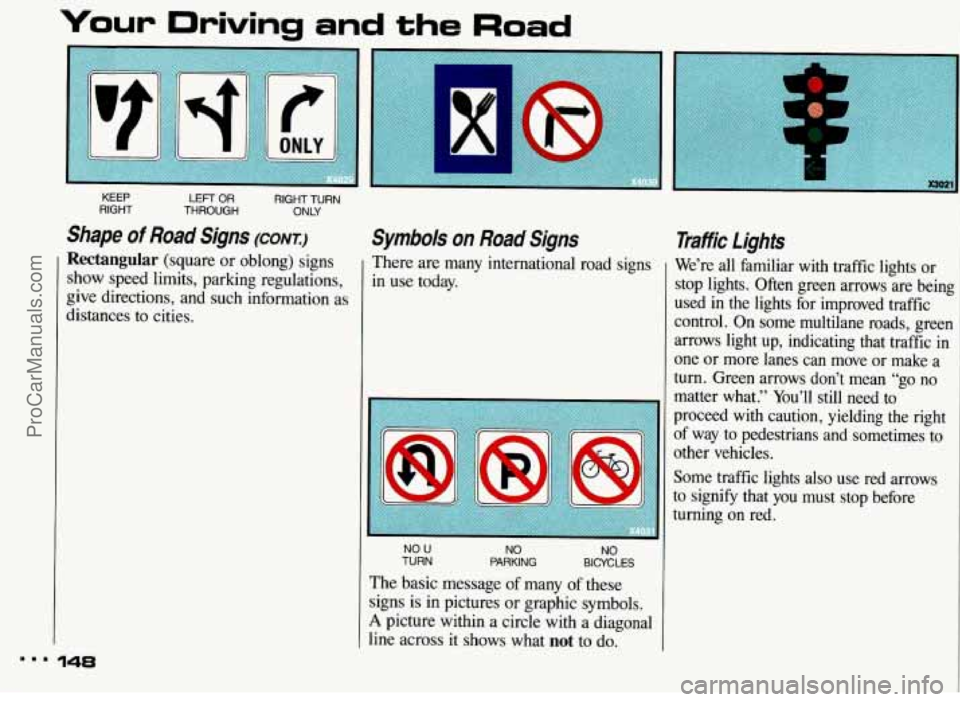
Your Uriving and the Road
KEEP LEFT OR RIGHT TURN
RIGHT THROUGH ONLY
Shape of Road Signs (CONI:)
Rectangular (square or oblong) signs
show speed limits, parking regulations,
give directions, and such information as
distances to cities.
I
Symbols on Road Signs
There are many international road signs
in use today.
NO U NO TURN
PARKING BICYCLES NO
The basic message of many of these
signs is in pictures or graphic symbols.
A picture within a circle with a diagonal
line across it shows what
not to do.
Traffic Lights
We’re all familiar with traffic lights or
stop lights. Often green arrows are being
used in the lights for improved traffic
control. On some multilane roads, green
arrows light up, indicating that traffic
in
one or more lanes can move or make a
turn. Green arrows don’t mean “go no
matter what.” You’ll still need to
proceed with caution, yielding
the right
of way to pedestrians and sometimes to
other vehicles.
Some traffic lights also use red arrows
to signify that you must stop before
turning on red.
m.. 148
ProCarManuals.com
Page 150 of 322
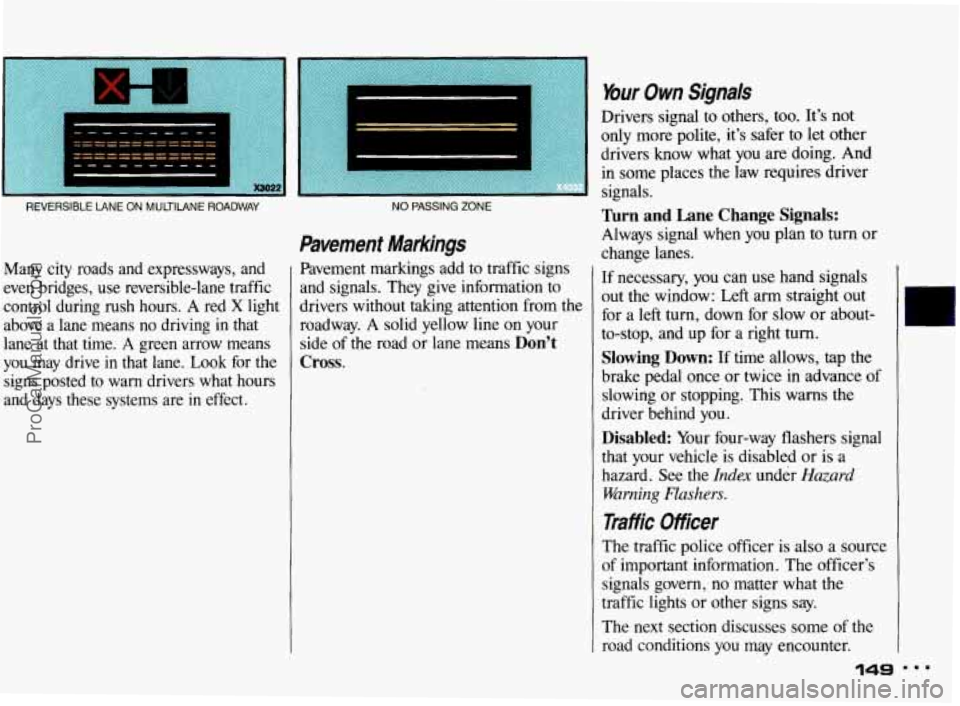
REVERSIBLE LANE ON MULTllANE ROADWAY
Many city roads and expressways, and
even bridges,
use reversible-lane traffic
control during rush hours.
A red X light
above a lane means
no driving in that
lane at that time.
A green arrow means
you may drive in that lane. Look for the
signs posted to warn drivers what hours
and days these systems are in effect.
bur Own Signals
Drivers signal to others, too. It’s not
only more polite, it’s safer to let other
drivers know what
you are doing. And
NO PASSING ZONE
Pavement Markings
Pavement markings add to traffic signs
and signals. They give information
to
drivers without taking attention from the
roadway. A solid yellow line on your
side
of the road or lane means Don’t
Cross.
in some places the iaw requires driver
signals.
“urn and Lane Change Signals:
Always signal when you plan to turn or
change lanes.
If necessary, you can use hand signals
out the window: Left arm straight out
for a
left turn, down for slow or about-
to-stop, and up for a right
turn.
Slowing Down: If time allows, tap the
brake pedal once
or twice in advance of
slowing or stopping. This warns the
driver behind you.
Disabled: Your four-way flashers signal
that your vehicle is disabled or is a
hazard. See the
Index under Hazard
Warning Flashers.
Tm#k Officer
The traffic police officer is also a source
of important information. The officer’s
signals govern, no matter what the
traffic lights or other signs say.
The next section discusses some of the
road conditions
you may encounter.
149
ProCarManuals.com
Page 162 of 322
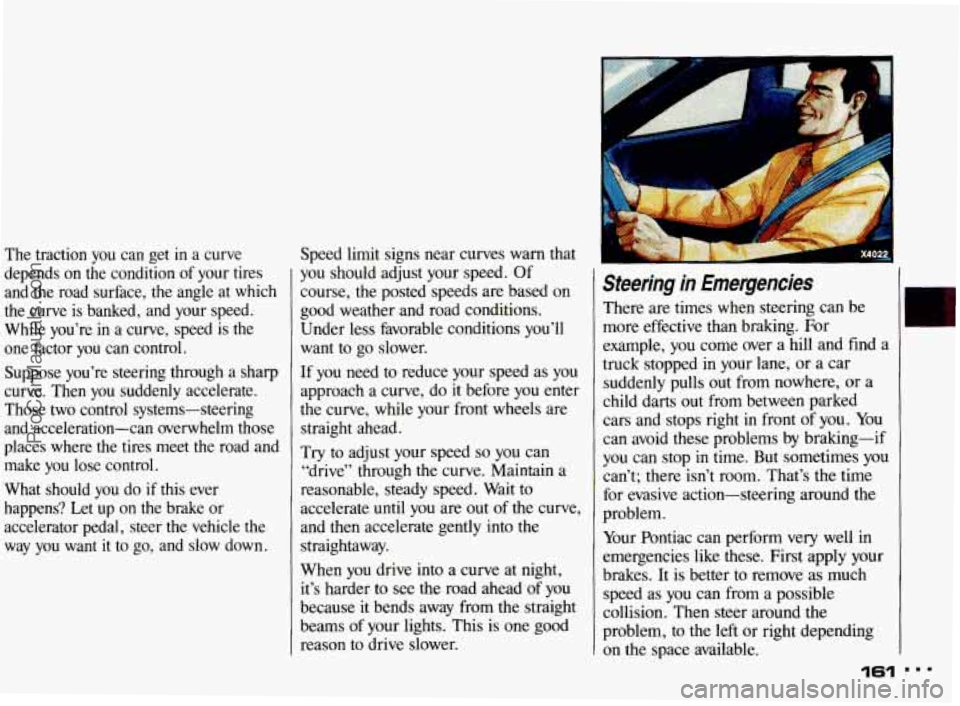
The traction you can get in a curve
depends on the condition of your tires
and the road surface,
the angle at which
the curve is banked, and your speed.
While you’re
in a curve, speed is the
one factor you can control.
Suppose you’re steering through a sharp
curve. Then you suddenly accelerate.
Those two control systems-steering
and acceleration-can overwhelm those
places where the tires meet the road and make you lose control.
What should you do if this ever
happens? Let up on
the brake or
accelerator pedal, steer the vehicle the
way you want it to go, and slow down. Speed limit signs near
curves warn that
you should adjust your speed. Of
course, the posted speeds are based on
good weather and road conditions.
Under less favorable conditions you’ll
want to go slower.
If you need to reduce your speed as you
approach a curve, do
it before you enter
the curve, while your front wheels are
straight ahead.
Try to adjust your speed
so you can
“drive” through the curve. Maintain a
reasonable, steady speed. Wait to
accelerate until you are out of the curve,
and then accelerate gently into the
straightaway.
When you drive into a curve at night,
it’s harder to see the road ahead of you
because it bends away from the straight
beams of your lights. This
is one good
reason to drive slower.
Steering in Emergencies
There are times when steering can be
more effective than braking. For
example, you come over a hill and find a
truck stopped in your lane, or a car
suddenly pulls out from nowhere, or a
child darts
out from between parked
cars and stops right in front of you. You
can avoid these problems by braking-if
you can stop
in time. But sometimes you
can’t; there isn’t room. That’s the time
for evasive action-steering around the
problem.
Your Pontiac can perform very well in
emergencies like these. First apply your
brakes.
It is better to remove as much
speed as you can from a possible
collision. Then steer around the
problem, to the left or right depending
on the space available.
161
ProCarManuals.com
Page 165 of 322
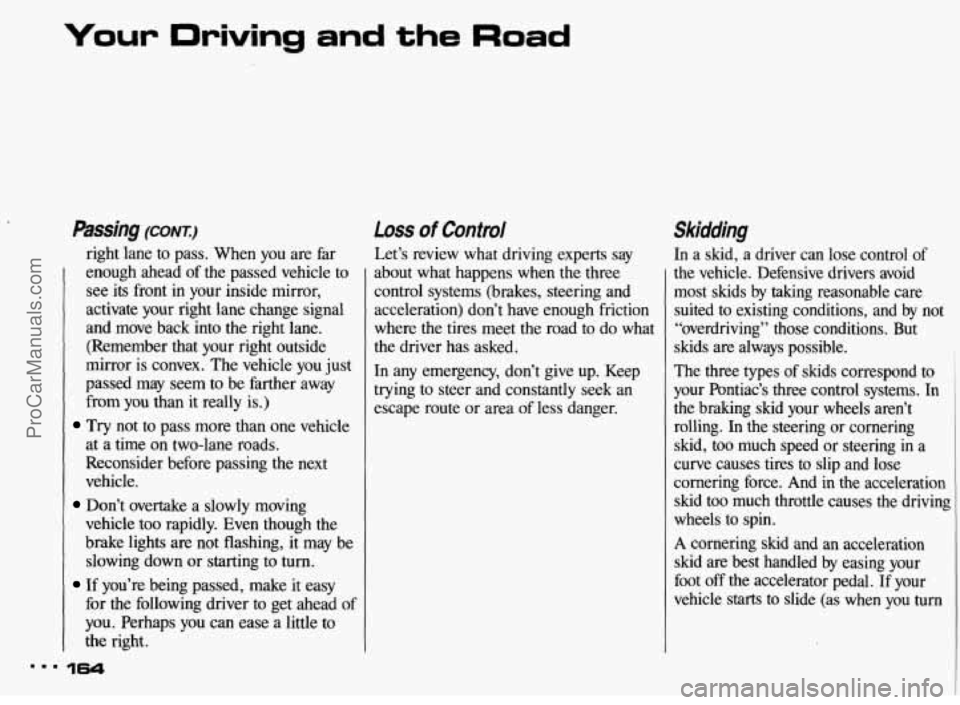
Your Driving and the Road
Passing (CONX:)
right lane to pass. When you are far
enough ahead of the passed vehicle to
see its front in your inside mirror,
activate your right lane change signal
and move back into the right lane.
(Remember that your right outside
mirror is convex. The vehicle you just
passed may seem to be farther away
from you than it really is.)
Try not to pass more than one vehicle
at a time on two-lane roads.
Reconsider before passing the next
vehicle.
vehicle too rapidly. Even though the
brake lights are not flashing,
it may be
slowing down or starting to
turn.
If you’re being passed, make it easy
for the following driver to get ahead
of
you. Perhaps you can ease a little to
the right.
Don’t overtake a slowly moving
Loss of Control
Let’s review what driving experts say
about what happens when the three
control systems (brakes, steering and
acceleration) don’t have enough friction
where the tires meet the road to do what
the driver has asked.
In any emergency, don’t give up. Keep
trying to steer and constantly seek
an
escape route or area of less danger.
Skidding
In a skid, a driver can lose control of
the vehicle. Defensive drivers avoid
most skids by taking reasonable care
suited to existing conditions, and by not
“overdriving” those conditions. But
skids are always possible.
The three types of skids correspond to
your Pontiac’s three control systems. In
the braking skid your wheels aren’t rolling. In the steering or cornering
skid, too much speed or steering in a
curve causes tires to slip and lose
cornering force. And in the acceleration
skid too much throttle causes the driving
wheels
to spin.
A cornering skid and an acceleration
skid are best handled by easing your
foot
off the accelerator pedal. If your
vehicle starts to slide (as when
you turn
ProCarManuals.com
Page 166 of 322
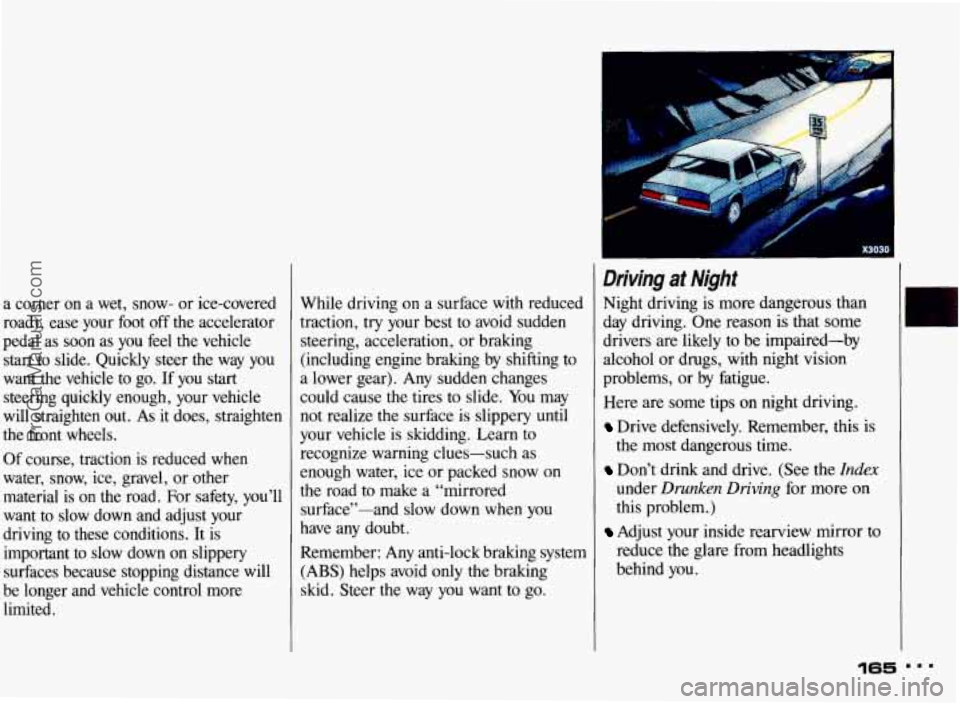
a corner on a wet, snow- or ice-covered
road), ease your foot off the accelerator
pedal as soon as you feel the vehicle
start to slide. Quickly steer the way you
want the vehicle to go. If you start
steering quickly enough, your vehicle
will straighten out. As it does, straighten
the front wheels.
Of course, traction is reduced when
water, snow, ice, gravel, or other
material is
on the road. For safety, you’ll
want to slow down and adjust your
driving to these conditions. It is
important to slow down on slippery
surfaces because stopping distance will
be longer and vehicle control more
limited. While
driving on a surface with reduced
traction, try your best
to avoid sudden
steering, acceleration, or braking
(including engine braking by shifting
to
a lower gear). Any sudden changes
could cause the tires to slide. You may
not realize the surface
is slippery until
your vehicle is skidding. Learn to
recognize warning clues-such as
enough water, ice
or packed snow on
the road to make a “mirrored
surface”-and slow down when
you
have any doubt.
Remember: Any anti-lock braking system
(ABS) helps avoid only the braking
slud. Steer the way you want to go.
Driving at Night
Night driving is more dangerous than
day driving. One reason is that some
drivers are likely to be impaired-by
alcohol or drugs, with night vision
problems, or by fatigue.
Here are some tips on night driving.
Drive defensively. Remember, this is
the most dangerous
time.
Don’t drink and drive. (See the Index
under Drunken Driving for more on
this problem.)
Adjust your inside rearview mirror to
reduce the glare from headlights
behind you.
165
ProCarManuals.com
Page 167 of 322
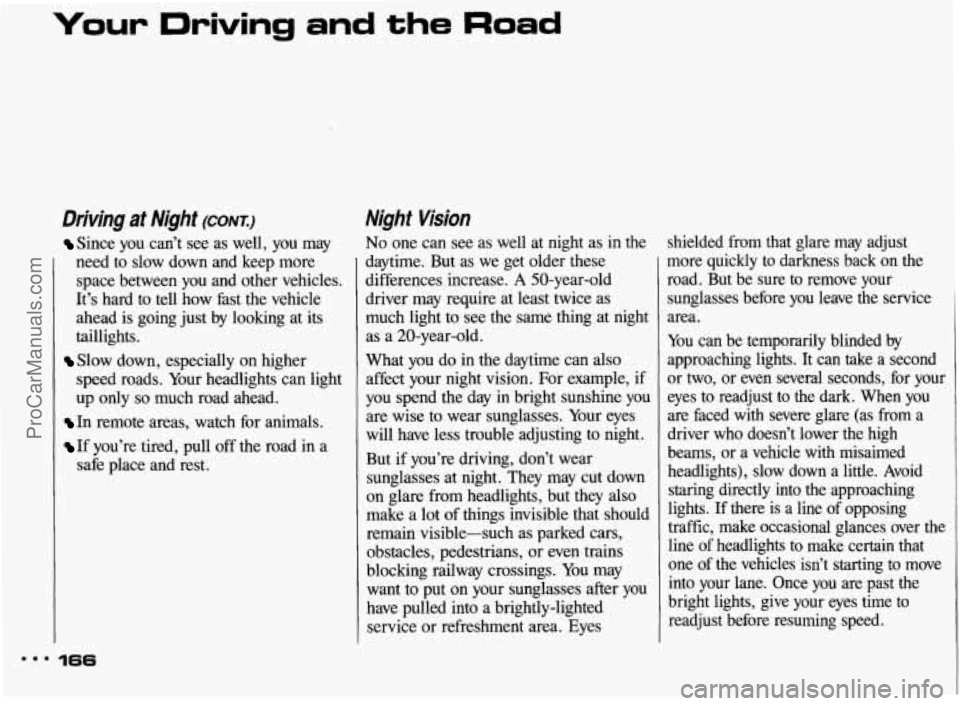
Your Driving and the Road
Driving at Night (CONT.:)
Since you can’t see as well, you may
need to slow down and keep more
space between you and other vehicles.
It’s hard
to tell how fast the vehicle
ahead is going just by looking at its
taillights.
Slow down, especially on higher
speed roads, Your headlights can light
up only
so much road ahead.
In remote areas, watch for animals.
If you’re tired, pull off the road in a
safe place and rest.
Night Hsion
No one can see as well at night as in the
daytime. But as we get older these
differences increase.
A 50-year-old
driver may require at least twice as
much light
to see the same thing at night
as a 20-year-old.
What you do in the daytime can also
affect your night vision. For example, if
you spend the day in bright sunshine you
are wise to wear sunglasses. Your eyes
will have less trouble adjusting to night.
But if you’re driving, don’t wear
sunglasses at night. They may cut down
on glare from headlights, but they also
make a lot of things invisible that should
remain visible-such as parked cars,
obstacles, pedestrians, or even trains
blocking railway crossings.
You may
want to put
on your sunglasses after you
have pulled into a brightly-lighted
service or refreshment area. Eyes shielded from that glare
may adjust
more quickly to darkness back
on the
road. But be sure to remove your
sunglasses before you leave the service
area.
You can be temporarily blinded by
approaching lights. It can take a second or two, or even several seconds, for your
eyes to readjust to the dark. When you
are faced with severe glare (as from a
driver who doesn’t lower the high
beams, or a vehicle with misaimed
headlights), slow down a little. Avoid
staring directly into the approaching
lights.
If there is a line of opposing
traffic, make occasional glances over the line
of headlights to make certain that
one of the vehicles isn’t starting to move
into your lane. Once you are past the
bright lights, give your eyes time to
readjust before resuming speed.
mmm 166
ProCarManuals.com